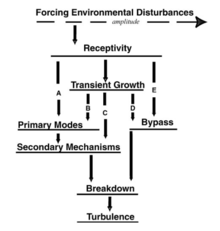Bypass transition: Difference between revisions
An article for Bypass Transition has been started. Bypass transition is an important sub category in Laminar turbulent transition. |
Category added |
||
| Line 1: | Line 1: | ||
'''Bypass Transition''' is a kind of laminar to turbulent transition in a flow over a surface, in which some of pre-transitional events which are generally occurring in natural |
'''Bypass Transition''' is a kind of laminar to turbulent transition in a flow over a surface, in which some of pre-transitional events which are generally occurring in natural [[Laminar–turbulent transition]], such as generation of two dimensional Tollmien-Schlichting waves, Spanwise vorticity and Three-dimensional vortex breakdown are bypassed and through some secondary instability mode the laminar boundary layer becomes turbulent boundary layer.[[File:Path to transition.png|thumb|alt=Morkovin's path to transition|The path from receptivity to laminar-turbulent transition as illustrated by Morkovin, 1994.<ref>Morkovin M. V., Reshotko E., Herbert T. 1994. "Transition in open flow systems—a reassessment". ''Bull. Am. Phys. Soc.'' 39:1882.</ref>]] |
||
==History== |
==History== |
||
P. S. Klebanoff is the first scientist who experimentally observed bypass transition scenario during his experiments in elevated free-stream turbulence flow. He identified an important aspects of the bypass transition. In his experiment, using hot wires he studied flow over a flat plate which was subjected to 0.3% free-stream turbulence level. At this moderate free-stream turbulence level, he could observe a low-frequency velocity perturbation signal, that is less than 12 Hz which is much smaller than usual Tollmien-Schlichting wave frequency. He also observed thickening and thinning of boundary layer which is not in the case of low free-stream turbulence flow.<ref>{{cite journal |last1=Kenndal |first1= James M.||date= |title=Experiments on Boundary Layer Receptivity to Free stream Turbulence |url=https://arc.aiaa.org/doi/abs/10.2514/6.1998-530 |journal=AIAA |volume= |issue= |pages= |doi=|access-date= }}</ref> |
P. S. Klebanoff is the first scientist who experimentally observed bypass transition scenario during his experiments in elevated free-stream turbulence flow. He identified an important aspects of the bypass transition. In his experiment, using hot wires he studied flow over a flat plate which was subjected to 0.3% free-stream turbulence level. At this moderate free-stream turbulence level, he could observe a low-frequency velocity perturbation signal, that is less than 12 Hz which is much smaller than usual Tollmien-Schlichting wave frequency. He also observed thickening and thinning of boundary layer which is not in the case of low free-stream turbulence flow.<ref>{{cite journal |last1=Kenndal |first1= James M.||date= |title=Experiments on Boundary Layer Receptivity to Free stream Turbulence |url=https://arc.aiaa.org/doi/abs/10.2514/6.1998-530 |journal=AIAA |volume= |issue= |pages= |doi=|access-date= }}</ref> |
||
| Line 7: | Line 7: | ||
==References== |
==References== |
||
{{reflist}} |
{{reflist}} |
||
[[Category:Boundary layers]] |
|||
[[Category:Turbulence]] |
|||
[[Category:Fluid dynamics]] |
|||
Revision as of 03:56, 31 October 2017
Bypass Transition is a kind of laminar to turbulent transition in a flow over a surface, in which some of pre-transitional events which are generally occurring in natural Laminar–turbulent transition, such as generation of two dimensional Tollmien-Schlichting waves, Spanwise vorticity and Three-dimensional vortex breakdown are bypassed and through some secondary instability mode the laminar boundary layer becomes turbulent boundary layer.

History
P. S. Klebanoff is the first scientist who experimentally observed bypass transition scenario during his experiments in elevated free-stream turbulence flow. He identified an important aspects of the bypass transition. In his experiment, using hot wires he studied flow over a flat plate which was subjected to 0.3% free-stream turbulence level. At this moderate free-stream turbulence level, he could observe a low-frequency velocity perturbation signal, that is less than 12 Hz which is much smaller than usual Tollmien-Schlichting wave frequency. He also observed thickening and thinning of boundary layer which is not in the case of low free-stream turbulence flow.[2]
Pre-transitional flow structures
In Bypass transition flow, the pre-transitional flow structures are quite different from those of very low turbulent intensity free-stream flow. From various laboratory experiments and computational studies, it has been observed that the low frequency streaky flow structures are present inside the laminar boundary layers. These streaky structures are called as Klebanoff mode or simply K-modes since this was first experimentally observed by the Klebanoff.[3]
References
- ^ Morkovin M. V., Reshotko E., Herbert T. 1994. "Transition in open flow systems—a reassessment". Bull. Am. Phys. Soc. 39:1882.
- ^ Kenndal, James M. "Experiments on Boundary Layer Receptivity to Free stream Turbulence". AIAA.
{{cite journal}}: Cite has empty unknown parameter:|1=(help) - ^ Matsubara, M.; Alfredsson, P. H. (2001). "Disturbance growth in boundary layers subjected to free-stream turbulence". Journal of Fluid Mechanics. 430: 149–168.
{{cite journal}}: Cite has empty unknown parameter:|1=(help)
